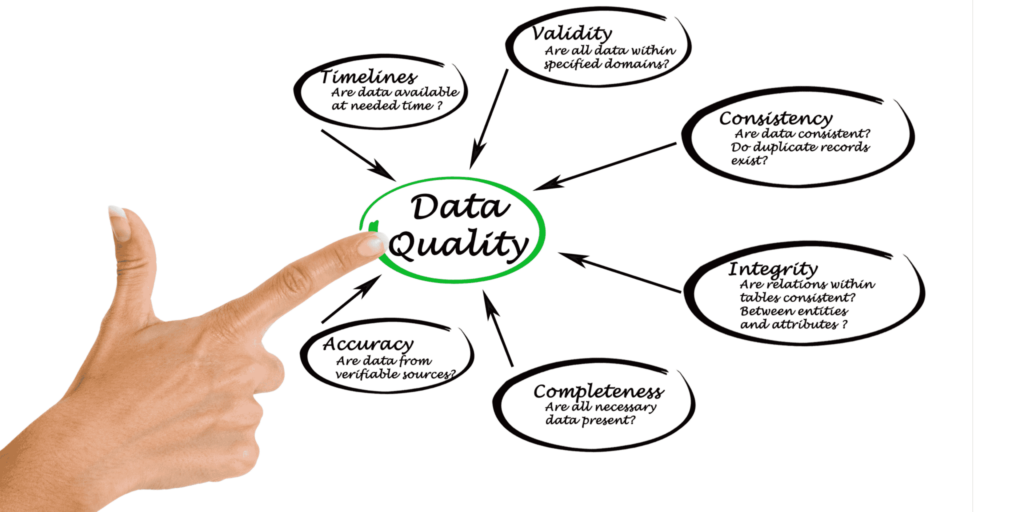Are you concerned about the quality of your data? If so, you should consider using data quality metrics to ensure that your data is accurate and reliable.
Data quality metrics are tools that help you measure the quality of your data. They can help you identify errors and inconsistencies and track changes over time. By using data quality metrics, you can improve the quality of your data and make better decisions about your data.
But what data quality metrics make the most difference in data collection and intelligence? This post reveals all, plus we show you the secret to getting these metrics via web scraping.
What data quality metrics are most important to keep track of?
A few different data quality metrics are important to measure, depending on what type of data you are working with. For example, suppose you are working with customer data. In that case, it is important to measure things like accuracy (are the customer records accurate?), completeness (are all of the required fields filled in?), and timeliness (is the data being updated promptly?).

Other important data quality metrics include things like consistency (is the data consistent across different sources?), uniqueness (are there duplicate records?), and validity (is the data within the correct range?). It is also important to track how often data quality issues are occurring (lineage and integrity) and to have a process in place to quickly fix any issues that arise.
Let’s take a closer look at them.
Accuracy.
Accuracy is a data quality metric that refers to the percentage of correctly classified or labeled data. For example, if a dataset contains 100 records and 90 are correctly labeled, then the accuracy is 90%.
There are a few ways to calculate accuracy, but the most common is to use the formula:
Accuracy = (True Positives + True Negatives) / Total Number of Records
True positives are the records that are correctly labeled as positive, and true negatives are the records that are correctly labeled as negative.
Regarding accuracy, it is important to remember that it is not always the most important metric. For example, suppose you are trying to predict whether or not a patient has a disease. In that case, you may be more concerned with the false positive rate (the percentage of healthy patients incorrectly labeled as diseased) than the accuracy.
Completeness.
Completeness, on the other hand, refers to the degree to which all relevant data has been included in the dataset. Completeness is a measure of data quality that assesses how much of the data that should be present is actually present. Data can be incomplete for a variety of reasons, including missing values, incorrect values, and values that are not up to date. Completeness is important because it can impact the accuracy and usefulness of the data.
Timeliness.
One important aspect of data quality is timeliness, which refers to how recent the data is. Timeliness is important because data that is too old may not be relevant or accurate anymore. For example, data about the number of people who have died from a disease may not be accurate if it is from 10 years ago.
There are two main ways to measure timeliness: real-time and near-real-time. Real-time data is data that is collected and processed as it is generated. Near-real-time data is collected and processed shortly after it is generated.
Which of these two methods is used depends on the specific application. For example, real-time data would be more important to make decisions based on the most up-to-date information if data is being used to monitor a disease outbreak.
Consistency.
Consistency is important when measuring data quality because it ensures that the data is comparable across different measurements. If the data is inconsistent, it is difficult to compare and understand. Many factors can affect data consistency, such as the measurement method, time, and environment in which the measurement is taken. To ensure consistency, it is important to use the same measurement method, take measurements simultaneously, and control for other variables that could affect the data.
Uniqueness.
Another way to think about measuring data quality is in terms of uniqueness. That is, how unique is each piece of data? For example, if you have a dataset of customer names and addresses, you might want to know how many unique names and addresses there are. This can be a good way to measure data quality because if there are a lot of duplicates, it may mean that the data is not very accurate.
Validity.
Validity is the extent to which a measure accurately reflects the construct it is intended to measure. For a measure to be valid, it must first be reliable. This means that the measure must produce consistent results across different occasions and different measures. If a measure is not reliable, it cannot be valid.
There are two types of validity: content and construct.
- Content validity is the extent to which a measure covers the entire construct it is intended to measure. For example, a measure of anxiety that only assesses fear of flying would not have good content validity because it would not cover all aspects of anxiety.
- Construct validity is the extent to which a measure accurately reflects the theoretical construct it is intended to measure. For example, a measure of anxiety that includes items about fear of flying, public speaking, and heights would have good construct validity because it would be measuring the construct of anxiety.
There are several ways to establish validity, including expert consensus, face validity, convergent validity, discriminant validity, and predictive validity.
- Expert consensus is when experts in the field agree that a measure is a good measure of the construct it is intended to measure.
- Face validity is when a measure appears to measure what it is supposed to measure.
- Convergent validity is when a measure correlates with other measures of the same construct.
- Discriminant validity is when a measure does not correlate with measures of other constructs. Predictive validity is when a measure predicts future outcomes.
Lineage.
Lineage is the process of tracking the origins and movements of data items as they flow through an organization. It is a key component of data quality management, as it allows organizations to trace the history of data items and identify any errors that may have occurred during their processing. Lineage can be used to assess the quality of data items, identify potential problems in data processing, and determine the root causes of data quality issues.
Integrity.
Regarding measuring data quality, integrity refers to the accuracy and completeness of the data. In other words, it measures how well the data represents the real-world phenomenon it is supposed to measure. Data with high integrity is accurate and complete, while data with low integrity is inaccurate and/or incomplete.
There are a number of ways to measure data integrity, but one of the most common is the percentage of missing values. A high percentage of missing values indicates low data integrity, as a large portion of the data is unavailable for analysis. Another common measure is the percentage of invalid values. Invalid values are values that do not meet the requirements of the data set (for example, if a data set requires all values to be positive, then a negative value would be considered invalid). A high percentage of invalid values also indicates low data integrity.
Data integrity is important because it affects the accuracy of any analyses performed on the data. Inaccurate or incomplete data can lead to incorrect conclusions. For example, if a data set contains many missing values, any conclusions drawn from that data set may be inaccurate. Similarly, if a data set contains a large number of invalid values, then any conclusions drawn from that data set may also be inaccurate.
It is important to note that data integrity is not the same as data quality. Data quality refers to the overall usefulness of the data, while data integrity refers specifically to the accuracy and completeness of the data. Data can be of high quality but have low integrity (for example, if it is old and no longer accurate), or data can be of low quality but have high integrity (for example, if it is of poor quality but is still complete and accurate).
Web scraping and residential proxies.
There are a lot of data quality metrics that businesses need to track to ensure that their data is clean and accurate. However, manually tracking these metrics can be time-consuming and expensive. To keep up, it’s crucial to use the right web scraping tools to help harvest and analyze the data.
For an in-depth look, check out Free Web Scraping Tools.
Web scraping using IPBurger’s residential proxies is the best way to get accurate data quality metrics. Proxies allow you to quickly and easily scrape data from multiple sources, providing accurate and up-to-date data you can trust.


